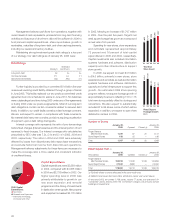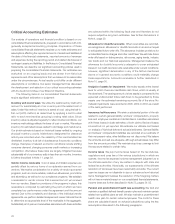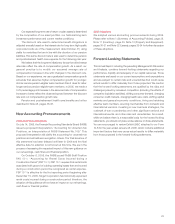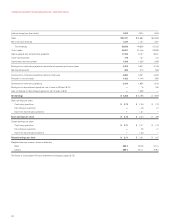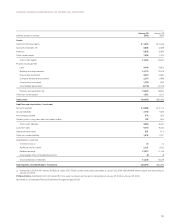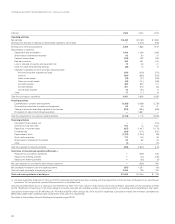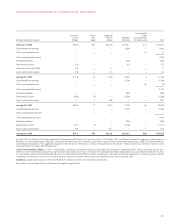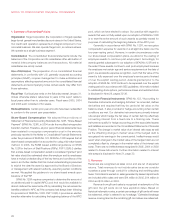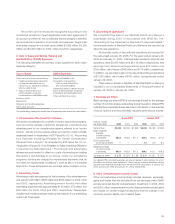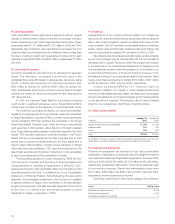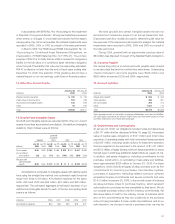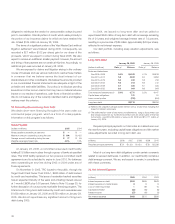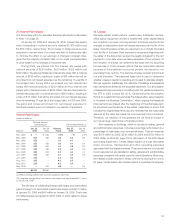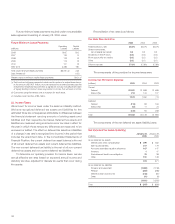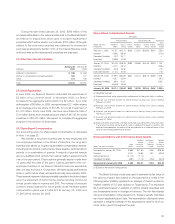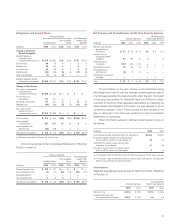Target 2005 Annual Report Download - page 32
Download and view the complete annual report
Please find page 32 of the 2005 Target annual report below. You can navigate through the pages in the report by either clicking on the pages listed below, or by using the keyword search tool below to find specific information within the annual report.
30
9. Cash Equivalents
Cash equivalents include highly liquid investments with an original
maturity of three months or less from the time of purchase. We carry
these investments at cost, which approximates market value. These
investments were $1,172 million and $1,732 million in 2005 and 2004,
respectively. Also included in cash equivalents are proceeds due from
credit and debit card transactions with settlement terms of less than
five days. Credit and debit card receivables included within cash
equivalents were $285 million and $242 million, respectively, for 2005
and 2004.
10. Accounts Receivable
Accounts receivable are recorded net of an allowance for expected
losses. The allowance, recognized in an amount equal to the
anticipated future write-offs based on delinquencies, risk scores, aging
trends, industry risk trends and our historical experience, was
$451 million at January 28, 2006 and $387 million at January 29,
2005. Substantially all accounts continue to accrue finance charges
until they are written off. Accounts are written off when they become
180 days past due.
In 2004, we chartered Target Bank for the purpose of issuing
credit cards to qualified businesses, as our Target National Bank
charter does not allow for the issuance of commercial credit cards.
As a method of providing funding for our accounts receivable,
we sell on an ongoing basis all of our consumer credit card receivables
to Target Receivables Corporation (TRC), a wholly-owned bankruptcy
remote subsidiary. TRC then transfers the receivables to the Target
Credit Card Master Trust (the Trust), which from time to time will sell
debt securities to third parties, either directly or through a related
trust. These debt securities represent undivided interests in the Trust
assets. TRC has also retained an undivided interest in the Trust’s
assets that are not represented by the debt securities sold to third
parties and a 2 percent undivided interest in the Trust assets that is
held by Target National Bank, a wholly-owned subsidiary of Target
which also services receivables. TRC uses the proceeds from the
sale of debt securities and its share of collections on the receivables
to pay the purchase price of the receivables to Target.
The accounting guidance for such transactions, SFAS No.140,
“Accounting for Transfers and Servicing of Financial Assets and
Extinguishments of Liabilities (a replacement of SFAS No.125),”
requires the inclusion of the receivables within the Trust and any debt
securities issued by the Trust, or a related trust, in our Consolidated
Statements of Financial Position. Notwithstanding this accounting
treatment, the receivables transferred to the Trust are not available
to general creditors of Target. Upon termination of the securitization
program and repayment of all debt securities issued from time to time
by the Trust, or a related trust, any remaining assets could be
distributed to Target in a liquidation of TRC.
11. Inventory
Substantially all of our inventory and the related cost of sales are
accounted for under the retail inventory accounting method using the
last-in, first-out (LIFO) method. Inventory is stated at the lower of LIFO
cost or market. The LIFO provision is calculated based on inventory
levels, markup rates and internally-measured retail price indices. We
have not recorded any material LIFO provision in 2005 or 2004.
We routinely enter into arrangements with certain vendors whereby
we do not purchase or pay for merchandise until that merchandise is
ultimately sold to a guest. Revenues under this program are included
in the sales line in the Consolidated Statements of Operations, but
the merchandise received under the program is not included in our
Consolidated Statements of Financial Position because of the
simultaneous timing of our purchase and sale of this inventory. Sales
made under these arrangements totaled $872 million, $357 million
and $142 million for 2005, 2004 and 2003, respectively.
In 2005, we adopted SFAS No.151, “Inventory Costs, an
amendment of ARB No. 43, Chapter 4,” which clarifies that abnormal
amounts of idle facilities expense, freight, handling costs and spoilage
are to be recognized as current period charges and provides guidance
on the allocation of overhead. This adoption did not have a material
impact on our net earnings, cash flows or financial position.
12. Other Current Assets
January 28, January 29,
(millions) 2006 2005
Vendor income and other receivables $ 560 $ 428
Deferred taxes 344 344
Other 349 452
Total $1,253 $1,224
In addition to vendor income, other receivables relate primarily to pharmacy
receivables and merchandise sourcing services provided to third parties.
13. Property and Equipment
Property and equipment are recorded at cost, less accumulated
depreciation. Depreciation is computed using the straight-line method
over estimated useful lives. Depreciation expense for the years 2005,
2004 and 2003 was $1,384 million, $1,232 million and $1,068 million,
respectively. Accelerated depreciation methods are generally used
for income tax purposes. Repair and maintenance costs were
$474 million, $453 million and $393 million in 2005, 2004 and 2003,
respectively, and are expensed as incurred.
Estimated useful lives by major asset category are as follows:
Asset Life (in years)
Buildings and improvements 8 –39
Fixtures and equipment 4 –15
Computer hardware and software 4


